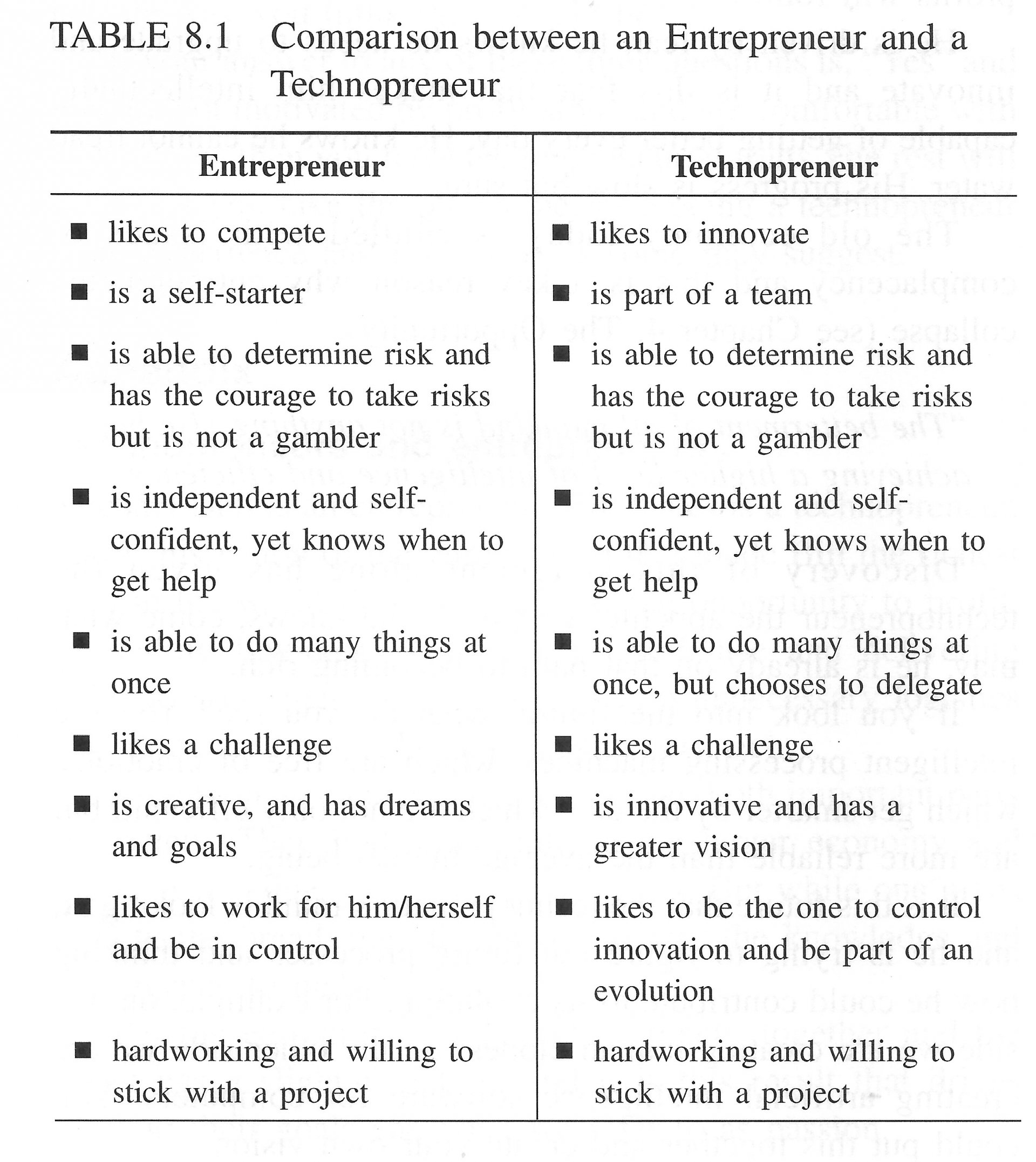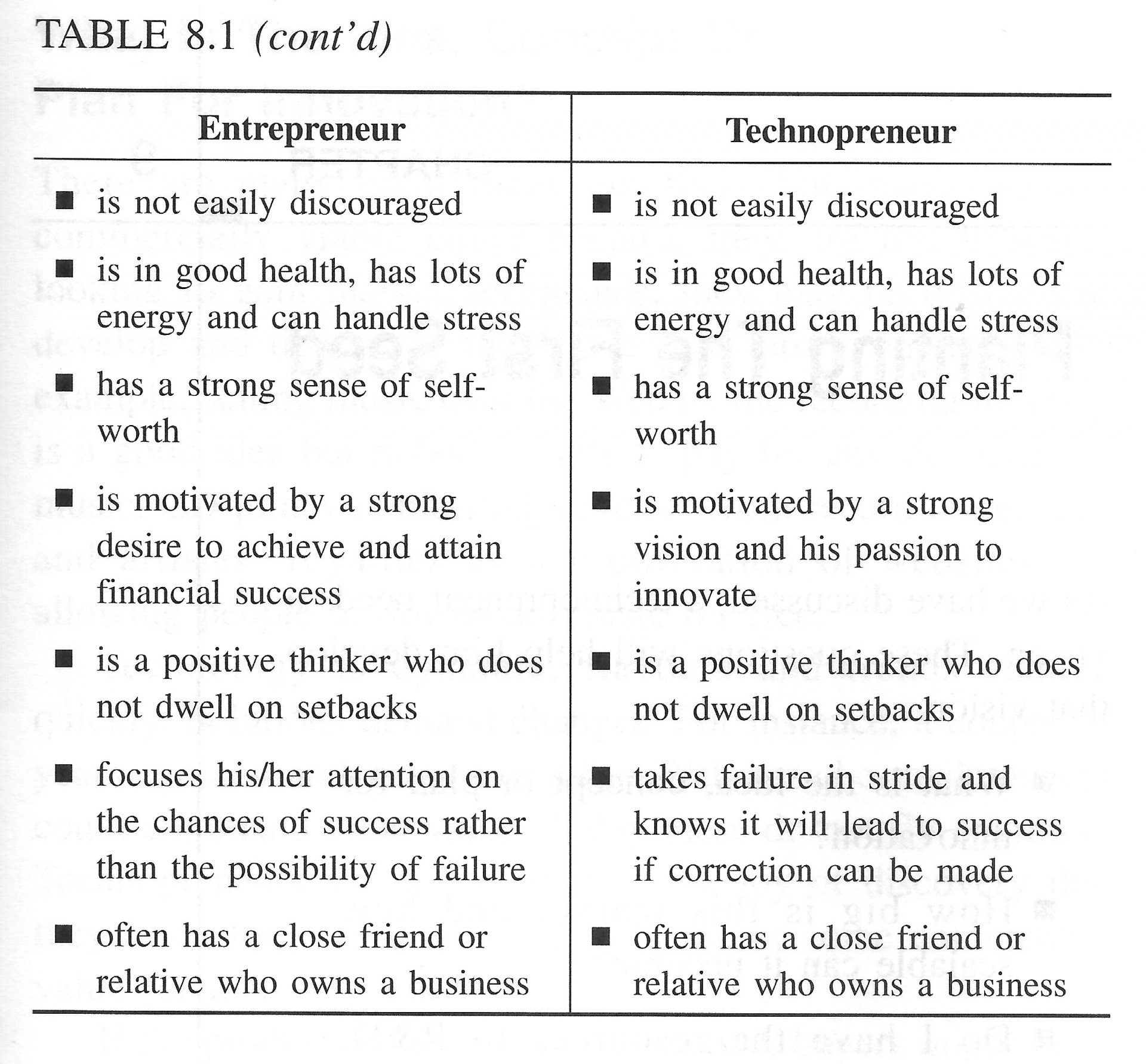Technopreneurship - Are you a Technopreneur?
To recap the lessons of the first part of this book, the opportunities are present.
*Markets are global and capital is not the most important determinant of a successful company.
*The pace of innovation is speeding up in line with technology.
*Individuals are taking huge amounts of risk upon the slightest identification of opportunity because the rewards are great.
*Big corporations are losing their edge. They had in the past ensured their survival via a monopolistic approach. The playing field has now been levelled, in favor of whoever could do the job or deliver the product, service or solution.
*Recessions are more than ever impacting on society in shorter periods of time.
*Never before have you seen corporations going from hero to zero in a matter of months.
All this has elightened us on the following:
*The Internet is still new and many have not yet figured out where we are heading.
*Brand value means very little for those operating in local markets. They have to say big and deliver around the world simultaneously.
*Investor psychology and markets move in cycles; they are never stationary.
*Customers hold the key to survival for most corporations. It is not the number of customers one has, but the amount of revenues that are derived from them that matters.
*Anyone from all walks of life can think of processes, ideas and solutions and profit from them. All that is required to synthesis know-how, passion and an appetite for risk.
Technopreneurs are the ones that identify the problem and capitalise on the opportunity. They are the ones who have the appetite for risk, are equipped with the know-how, have the vision and execute it
The question is, are you that technopreneur?
A technopreneur has two major characteristics. He does things not out of greed or for profit but because he wants to innovate, that is, change things, and he is comfortable working with, or using, technology.
Not For Profit Alone
Jerry Yang of Yahoo is a technopreneur. He envisaged the future of the Internet and from his dorm he created an index to help others find websites. He knew that at the speed the Internet was growing, there was a necessity to put all that information in one central location so that others can find those sites and access information with ease. He did not bother about profits. It was accidental to his vision. If his passion had been driven by profits, he would have faltered and will not be where he is today, a billionaire. Profit is greed and one of our failures.
Sabeer Bhatia of Hotmail, created a site to give others an e-mail account. He wanted to do good because in those days, an email account was a hot commodity and not everyone could access it. The results were similar to Jerry Yang‘s and he profited by default. Sameer and his team sold Hotmail to Microsoft for US$400 million. With his newfound wealth, Sabeer went into other ventures and failed. Only he knows whether he was driven by greed or by a vision in those other ventures. Greed makes us weaker and the only direction toward success is our vision.
These two examples illustrate the most important characteristic of a technopreneur. He is not driven by greed or the need to make profits. He is driven by the need to innovate or change.
An entrepreneur is not a technopreneur and vice versa. An entrepreneur is an opportunist, looking for profits in static situations. A technopreneur operates in dynamic situations and wants to innovate, hoping that profits may follow.
Or to put it another way, while the entrepreneur looks for opportunities and profits in new markets and products, the technopreneur creates new markets and products and it is this innovation that gives him profits by default.
The appendix at the end of the chapter explores further the differences between them.
Comfortable With Technology
The second element of being a technopreneur is the understanding of technology (see Chapter 7: De-mystifying Technology), its effects on society, its uses and its benefits. The technopreneurs featured in this book were not all technocrats themselves but they had a strong passion that enabled them to learn about and understand technologies.
They were frustrated with the way things were, and they were wanted to make some changes. But in order to make changes, they had to have skills.
During the dot.com days, there were just too many kids who were dropping out of school to set up their own organizations. Their inspiration was Bill Gates and his wealth, not the innovativeness that Bill had. They thought up processes which sounded good but were not commercially viable for for which the market was not ready.
There are, however, many kids who have also contributed to technology and its evolution greatly, and the determinant factor was they understood the problem. A solution for a problem that will arise five years in the making, has little or no value today as the problem has not occurred.
In identifying and solving problems, an understanding of the process of innovation is important.
Innovation
Innovation happens when something new is introduced. This could be a new product, discovering a fresh demand or supply, or changes in organizations, management or environments.
Management guru Peter Drucker describes innovation as a specific tool which, when exploited for change, can create an opportunity. Such changes once identified can offer opportunities in the same environment or a different business of service by means of efficiency our automation. He refers to this a systematic innovation.
According to him, systematic innovation consists of the purposeful and organized search for changes. It is this systematic analysis of the opportunities for change which might offer scope for economic and social innovation. He further adds three conditions that have to be fulfilled in order to be able to defined the problem.
1. Innovation at work requires knowledge and ingenuity. It makes great demands on diligence, persistence and commitment.
2. To to succeed, innovation must build on strengths.
3. Innovation always must be close to the market and be driven by the market.
These three sources lie within the enterprise, be it a business or a public service institution or within an industry or service sector. These are therefore, visible primarily to people within that industry or service sector. It’s importance of working within large organisations.
Technopreneurs who are part of large organisations we have the opportunity to identify issues that are only evident to the people inside and their contribution and systematic automation of the situation can provide the basis for change thereby offering them an opportunity.
While the above first three conditions are evident within an organization, there are external factors that contribute to changes. These are highly reliable indications of changes that have occurred or are likely to occur.
1. The unexpected success, then expected failure, the unexpected outside event.
2. The incongruity - between reality as it actually is and reality as it is assumed to be or ought to be.
3. Innovation in industry structure or market structure that catches everyone unaware.
This last set for innovative opportunities involves changes outside the enterprise or industry.
1. Demographics (population changes).
2. Changes in perceptions, mood and meeting.
3. New knowledge, both scientific and non-scientific.
Hence the need for knowledge and skills, be it a business, processes, industry, economic or social. We all need this knowledge to be able to recognize changes and make good use of it. We all saw the birth of the Internet and we are seeing the many changes happening in the marketplace today. Some of us will act on these changes in innovate, while the rest of us will watch opportunities pass us by. The difference between the two is knowledge of the lack of it.
One of the best ways to gain knowledge and hone skills is to be part of a dynamic organisation and experience from it. This not only contributes to learning of the know-how and processes, what enhances our overall knowledge of the use of innovation and efficiency. We are also able to pick up key lessons in organisational structures and cultures and operational management.
If you could add to all this, some sales or customer interaction experiences, it will contribute to the development of a true technopreneur that is all of us.
Do You Have The Other Technopreneurial traits?
Do you think there’s a better way of doing something that everyone takes for granted? Would you push the limits for delivering theat perfect solution. Could you afford the risk of making changes to a system that only you think has flaws (remember that innovation often flirts with rules created by society, some are acceptable, and most are not)?
Finally, do you get frustrated and angry when things are not the way you think they should be?
If your answer to any of these three questions is, “Yes“ and you are not motivated by profit alone and are comfortable with technology, then you have technopreneurial traits. The rest will follow as he take the plunge because being a technopreneur is an experience and not an art as some may suggest.
Appendix
Technopreneurs and Entrepreneurs
Michael Dell is an entrepreneur. Bill Gates is a technopreneur. It was his vision of the wired world that may build richest man in the world. Michael Dell saw an opportunity to profit, by selling low-cost PCs from a warehouse and delivering value to consumers by cutting down on unnecessary logistics and associated costs; he too became very rich.
Entrepreneurs and technopreneurs are both important parts of society. The both contribute to the larger economy and they create value, jobs and opportunities. But while one give society the bread, the other gives society the knowledge and intelligence to make that bread.
Put the entrepreneur and technopreneur together as a result has a slight variation, and it is this result of drives them to their goals and what we refer to as passion.
ENTREPRENEUR = Product + Market = profits.
TECHNOPRENERUR = Today + Future = vision.
It is the realization of this vision for the technopreneur that has already made him rich, while the intrapreneur has yet to execute his business plan and strategy strategy to realise his profits. For the technopreneur, his profit is in knowing the future and he knows his worth even before his strategy is executed. He knows as long as he executes his role in order, by default profits will follow.
He is driven by fear, he knows he needs to upgrade and innovate and it is this fear that makes him intellectually capable of getting better every day. He knows he cannot tread water. His progress is slow but sure.
The old economy today is riddled with issues of complacency and this is a key reason why entrepreneurs collapse (see Chapter 4: The Opportunity).
“The betterment of all mankind is not anything else but achieving a higher level of intelligence in efficiency.“
Discovery of this statement alone has given the technopreneur the appetite for risk for he knows, come with may, he is already on the path to becoming rich.
If you look into the future, what do you see? You see intelligent processing machines, which are free of emotions, which get smarter by the day, which are not only efficient, but are more reliable than the average human being.
It is this future that the technopreneur's mind is looking at, and he is trying to figure out future processes and thinking how he could contribute to its evolution. For example, on one side we are creating human clones; on the other side we are creating artificial intelligence software for computers. You could put this together and create your own vision.
Sim Wong Hoo of Creative Technologies created the world's first sound card. It was his vision to change the desktop computers to a music machine. It was his vision that made the entire nation of singapore proud. No discussion of innovation is made in Singapore today without Sim Wong Hoo's name being mentioned. It became rich by default.
In conclusion, the similarities and differences between an entrepreneur and technopreneur are summarized as follows (see Table 8.1).


Chapter 8 Are you a Technopreneur? >>>
Technopreneurship Development - A Role for Society in Technopreneurship Development, a chapter written in 2002, explains the creative destructive forces at work in practically every aspect of human life and the reasoning for the massive confusion, leading up to revolutions, lack of employment opportunities and governments fiscal deficits. Technology is usually blamed for making the world a smaller place, the writing was on the wall since the late nineties, this chapter refreshes our memories.
Technopreneurship - The Successful Entrepreneur in the New Economy - Daniel Mankani. Published 2003. Pearson Education Asia - All rights, copyright reserved Daniel Mankani { ISBN0-13-046545-3 }







